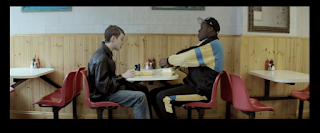Setting the scene, establishing shot. Location is central in the frame. Cheap family diner on a high street - working class location?

Two friends - One white, one black, shop chefs middle-eastern - diverse community. Both in centre of frame, sitting either side of table; setting scene up for conversation/dialogue.
Again, centre of frame, most important subject. Lights either side emphasise length of tunnel, emphasise length of pursuit. Slightly low angle shot, makes him look bigger in the frame.
Shot of blood, shows extent of damage done. 'Realisation' moment for audience, shows the damage gang violence can cause. High angle shot of blood makes it look like it's coming out of a tap; heightens severity of injury.
Point in film where tension peaks - diagetic, non-diagetic sound all heighten, and after this shot flashbacks end, and the rest of the 'Ellington Kid' narrative is left to the audience's imagination.




Comments
Post a Comment